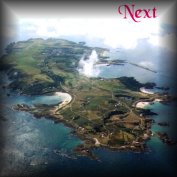This area, from the top of the west coastal slope to the edges of the Town area of St. Anne, includes most of La Petite Blaye the, still largely unfenced since mediæval times, lesser agricultural land. In the 1950s and 60s this was used as a co-operative vegetable and flower-growing area, early potatoes, some more exotic vegetables and up to 2 million daffodil and iris blooms were sent annually to Covent Garden Market and pickers were flown in from Lincolnshire to help gather the flower crop. Rising transport costs and the demise of the frequent boat services between the island and both Guernsey and England made the industry uncompetitive and today much of the land is reverting to gorse, bramble and bracken scrub.
Through the middle of this runs the island's principal stream. Rising from springs beneath two fields, called L'Essources "the sources" and L'Aie meaning "water or wetlands", situated either side of the entrance road to the Airport. The upper reaches flow across part of the land of Rose Farm, the first farm to be "enclosed" on Alderney, about 1830, which has two large ponds created by damming. This stretches down to Pont Martin where a small plot of land surrounding the old abreuvoir publique or public cattle-watering trough has been given to the Church and forms a quiet restful picnic spot, dedicated to St. Vignalis, the monk who reputedly brought Christianity to Alderney about AD 875. Just above this is a small swamp at the side of the stream where some of the island's few wetland orchids may sometimes be found. Below the garden the Bonne Terre valley sides are thickly tree-lined in the upper part and form steep bracken and scrub covered slopes further down. The patois name for "good land", given by the islanders for centuries to this area is something of a joke, it is corrupted from bonne pour rien "good for nothing". A somewhat overgrown path leads down stream to the former mill-leat; an area now much overgrown since the Watermill, sited lower down since at least the early 12th Century and last rebuilt about 1560, ceased to be used in the 1920s. This too is a site for a few wetland orchids and many of the commoner marsh plants already mentioned. Found only here in the island are a number of the tall pouffe-like stands of the Greater Tussock-sedge Carex paniculata.
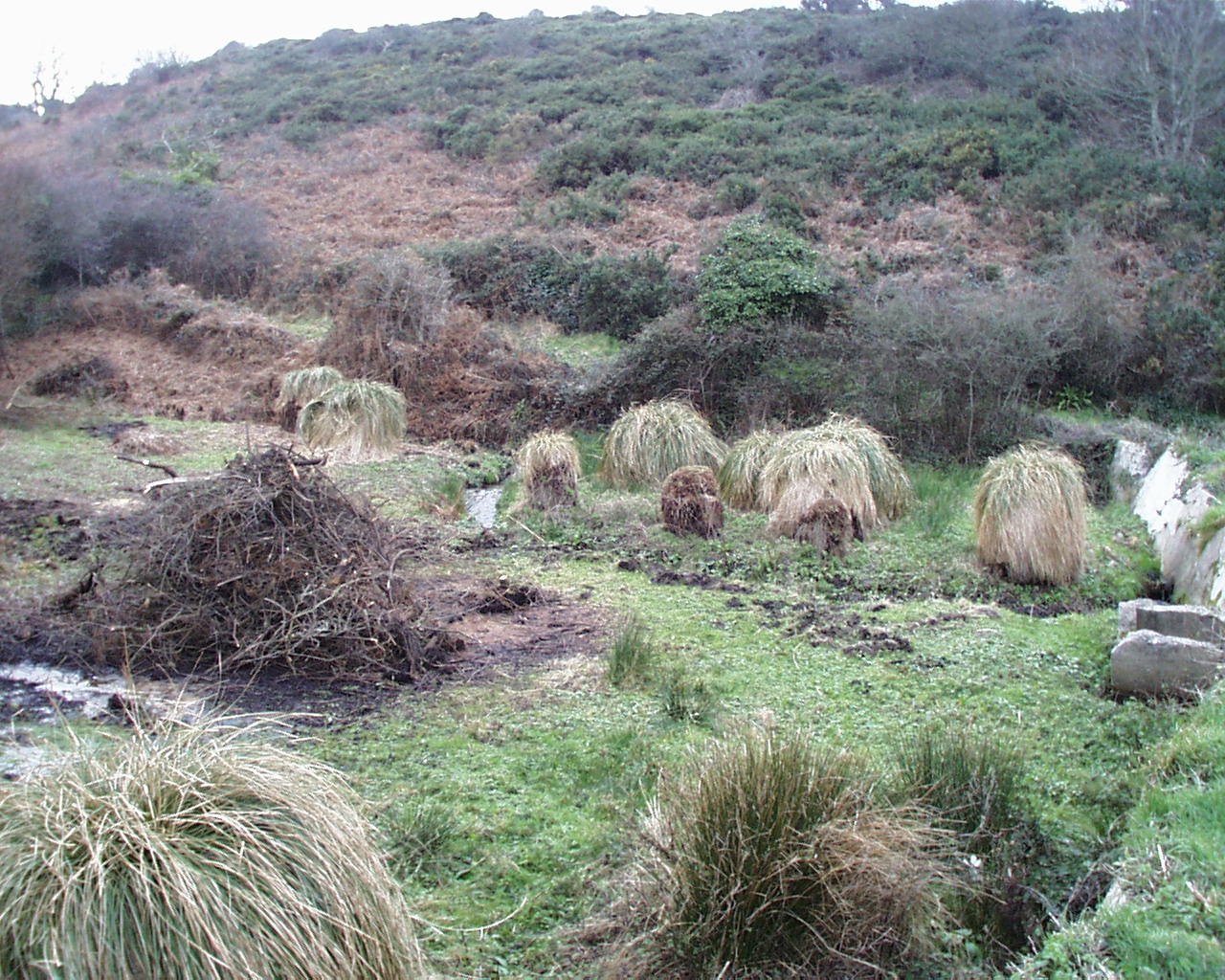
Figure 11. Great Tussock-sedge in the former mill leat
after scrub clearance in January 2000
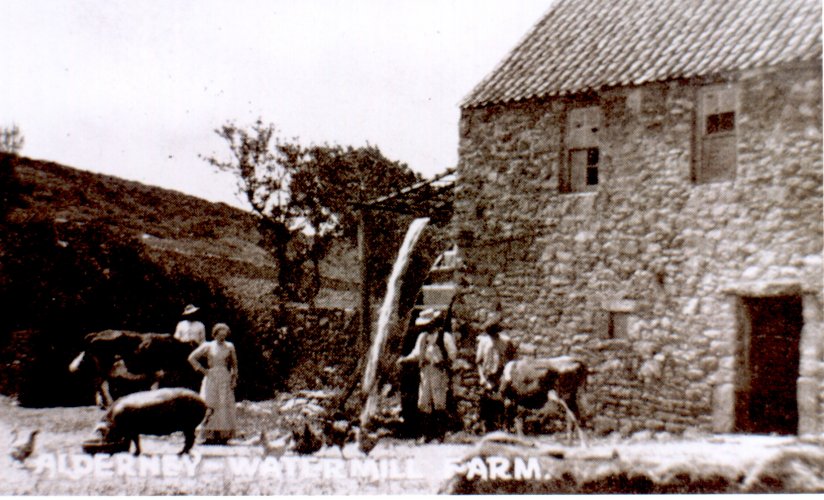
Figure 12. The Watermill about 1910
Note water flowing from top of the 'overshot' wheel
Not far below this, the path crosses to the other side of the stream at the long derelict site of one of the island's early lavoirets or public washing places and further below still is the modern pumping station of the waterworks. Water is filtered and pumped into the system from here. Extended mains piping, constructed in 1994/5, now makes it possible to pump much of the surplus all the way back to the main reservoir in Battery Quarry in times of high rainfall and/or low consumption. Another pond held back by a small dam with a spillway was made below here many years ago. Close by, hedges of Tamarisk Tamarix gallica, were well grown when they were recorded in E.D. Marquand's Flora of Guernsey and the Lesser Channel Islands, published in 1901. Either side of the stream, before it goes under the road, self-seeded plants of the spectacular Globe Artichoke with their huge mauve thistle heads in late summer, which have spread considerably in the last 10 years, are remnants of a crop planted in a small field nearby in the 1950s.
For centuries the bottom of this stream discharged into the sand dunes on Platte Saline, forming a large pond, (Fig. 13), just above the beach. Increased consumption of the water for domestic needs reduced this to a damp boggy area in the 1970s and 80s, home to several species of Sweet-grass Glyceria spp. the land form of Amphibious Bistort Persicaria amphibia, and large patches of Great Willowherb Epilobium hirsutum. In several drought years or those with low total rainfall, this dried up completely but the pond reformed after a particularly wet winter in 1993, after which several clumps of Galingale, not seen here for about 10 years reappeared, as well as a heavy growth of Least Duckweed, a quantity of the subtropical, floating, Water Fern Azolla filiculoides, recorded at several places in the island since 1972 and a few plants of Greater Spearwort. This has given nesting sites to several pairs of Mallard since then and, in 1996 a pair of Teal Anas crecca, raised 3 young here.
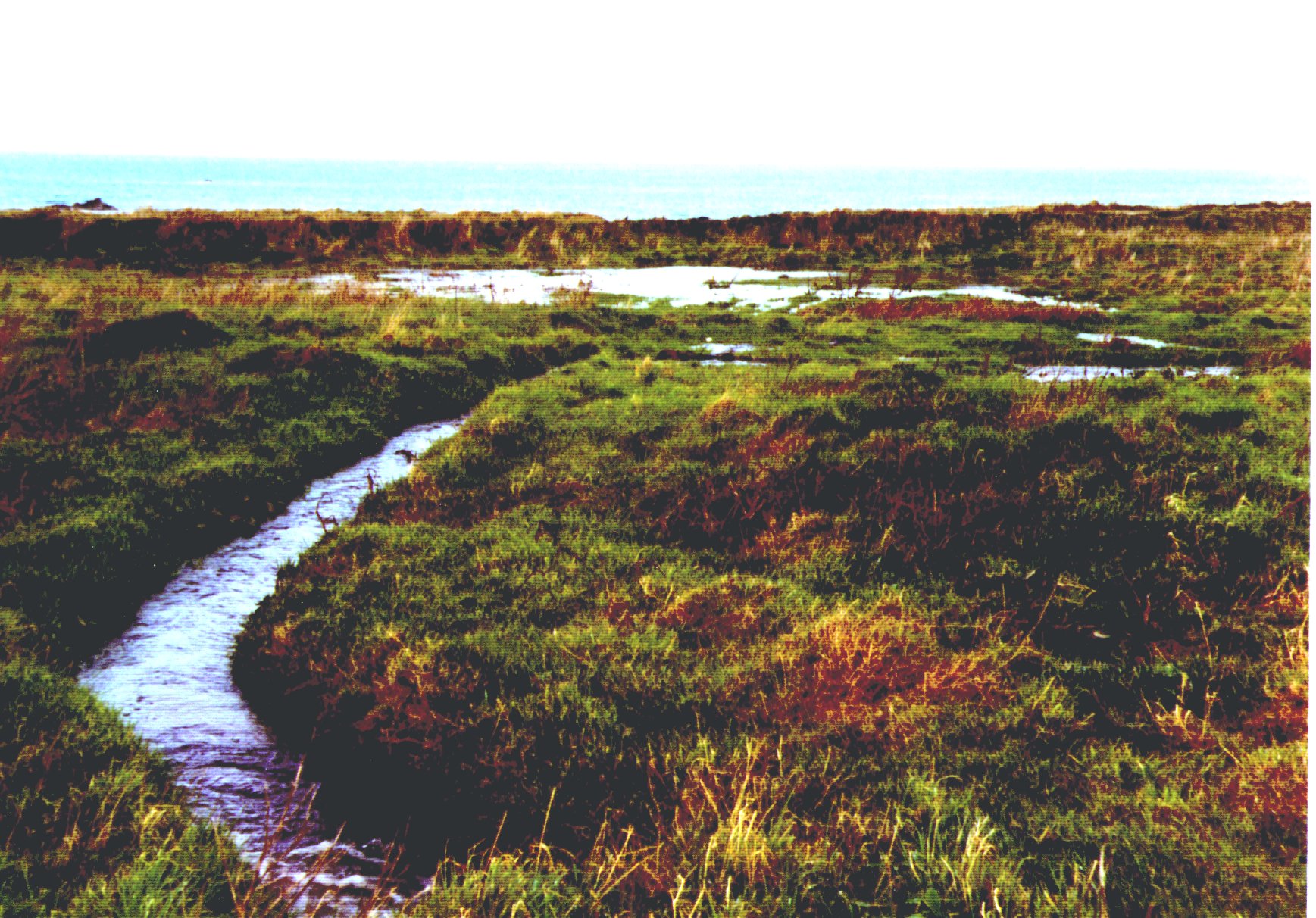
..........................
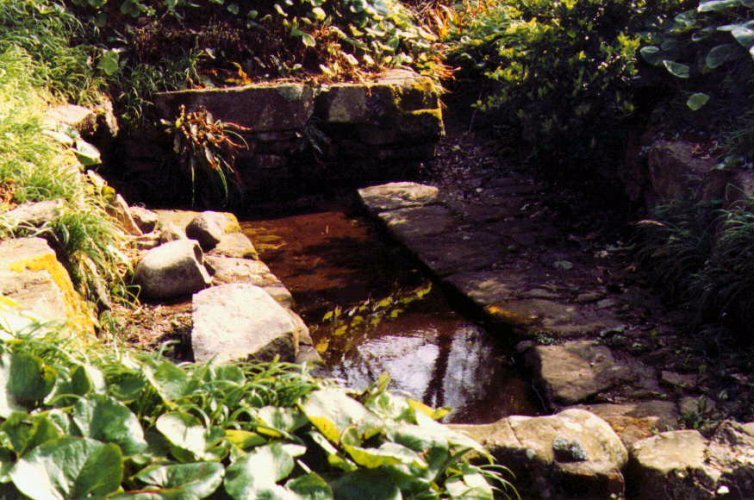 ...
...
< Figure 13. Platte Saline pond in 1995
Figure 14. Lavoiret at Ladysmith >
.
.
.
To the east of the Bonne Terre valley, in a smaller parallel watered valley, Le Val Vert Courtil, (part of the flow from which was diverted across Le Petit Val in former times, in a doüit, the line of which is still clear as a level track across a steeply sloping field, to boost the flow to the mill), is an area known as Ladysmith. There is some doubt whether this area was so named by the garrison troops to celebrate the relief of that town in the Boer War, or whether it is a corruption of Les Doüits from the stone lined channels of the only surviving Lavoiret, where the women from this side of the old town came to do their washing. Although closely surrounded by vegetation, the stone lavoiret is still in good condition, (Fig. 14). Wellington boots are advised for those making a visit. There is one of the largest abreuvoirs or cattle troughs in the island nearby, with somewhat grass covered, cobbled roadways leading down to it from the Petit Val roadway on either side. The cobbles are still clearly to be seen near the trough.
.

The stream in this valley also runs down to Platte Saline, in an underground pipe for part of its lower length. Below the road it discharges onto the land as a small stream with a few stunted Willows Salix spp. alongside, where, until about 3-4 years ago, it formed a bog where it finally sank into the sand. The author was responsible at that time for suggesting and overseeing the construction of a 20m. artificial pond to provide a permanent open water habitat for waterfowl and aquatic plants, the overflow from which is piped to the beach,
.....Figure 15. Ladysmith Trough c. 1912
rendering the surrounding land more suitable for recreational purposes. A pair of Mallard hatched 13 ducklings in the longer vegetation at the side of the pond in 1997, unfortunately these were largely taken by Crows in the first week, but three survived. Moorhen Galinula chloropus, Coot Fulica atra and other waterfowl have visited for short
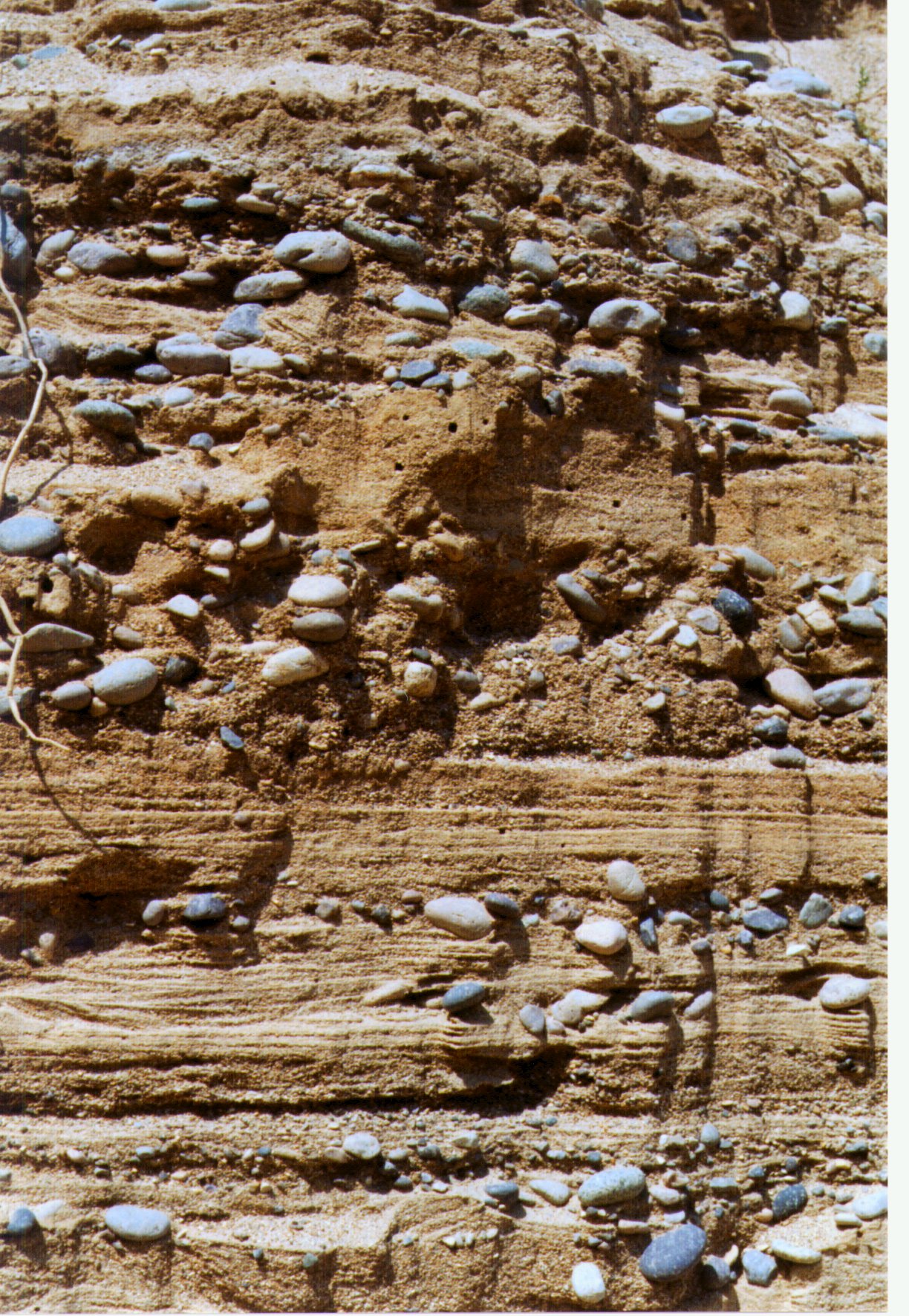 periods. A large White Water-lily plant Nymphæa spp. was introduced and a few marginals were planted. The pond rapidly became colonised with a dense growth of Curly Waterweed Lagarosiphon major and huge numbers of Pond Snails Lymnæa spp. and Freshwater Shrimps Gammarus spp. were present within weeks, the snails growing to about 3-4cm over the next few months, all presumably originating from further upstream.
periods. A large White Water-lily plant Nymphæa spp. was introduced and a few marginals were planted. The pond rapidly became colonised with a dense growth of Curly Waterweed Lagarosiphon major and huge numbers of Pond Snails Lymnæa spp. and Freshwater Shrimps Gammarus spp. were present within weeks, the snails growing to about 3-4cm over the next few months, all presumably originating from further upstream.
Platte Saline was an area of salt pans and was used as an éperquérie or fish drying and salting area in Elizabethan times. Dried, salted, Mackerel and Conger were exported to England, the island paying the Sovereign £10 p.a. in rental for the use of the Crown land. In Victorian times it was used as an exercise ground for the garrison and from 1936 until 1993/4 sand was excavated for building and road construction purposes. The sandpit gradually extended over about half of the surface area to a depth of about 10-15m. at which level it became unsuitable for building purposes. The sides of the pit showed many bands of stratification, with varying thicknesses of different sized grit where the dunes had built up over the millennia and in a number of Fig. 16. Stratification in the Sand Pit
places layers of larger pebbles suggested the level of the beach at various times, perhaps even as long ago as the several ice ages, (Fig. 16). The extension of the pit, on the seaward side, stopped well short of the area occupied by the pond with its patches of Galingale, Yellow Iris Iris pseudacorus and other marginal plants, inhabited before the Second World War by Sticklebacks Gasterosteus aculeatus, and other aquatic animal life. Beyond the pond again, a grassy area is a well established site for Giant Puffballs, Langermannia gigantea, a specimen of which, gathered in 1992, measured just over 1m. across and weighed 27lbs.
With the exhausting of suitable building sand, since then the pit has gradually been refilled with builder's rubble, old iron, garden refuse and spoil from the Victorian Battery Quarry, being cleared by the States for the Banquage housing scheme. At the time of writing, in January 2000, the infill is completed but has yet to be fully levelled and landscaped. It is proposed to use the site as a recreational area for both islanders and visitors, perhaps extending the sports facilities, originating with the Alderney Tennis Club, built about 5 years ago at the eastern end of the area, after that was back-filled.
As the filling in was extended, the gritty, quarry spoil, surface became colonised by many plant species. Early colonisers were Dove's-foot Cranesbill Geranium molle, Buck's-horn Plantain Plantago coronopus, several common grasses, Charlock Sinapis arvensis, Orache, Goosefoot, Mayweed and Dock species, large numbers of poppies, including Opium Poppies Papaver somniferum in a variety of colours and some more unusual plants, the seeds of all of which may well have survived for many years in the Victorian quarry spoil. These included Thornapple Datura stramonium, Apple-of-Peru Nicandra physalodes, Hare's-tail Grass Lagurus ovatus and Johnson-grass Sorghum halapense.
A number of species of fungi emerge from the coarse grit after rainstorms, including very large numbers of Ink-caps Coprinus comatus. Later colonists included large numbers of Perennial Wall-rocket Diplotaxis tenuifolia, Hoary Mustard Hirschfeldia incana, Sea Radish Raphanus raphanistrum subsp. maritima, Common Mallow Malva sylvestris Oxtongues Picris hieracoides and P. echioides, Yarrow Achillea millefolium, (frequently with pink flowers as well as white) and small quantities of Tansy, Tanacetum parthenium, Mugwort Artemesia vulgaris and Wormwood A. absinthum, Cudweeds Gnapthalium & Filago spp. and Canadian Fleabane Conyza canadensis. The Hare's-tail Grass has now spread to form small scattered clumps over most of the grassy area. A large area of recently spread bare soil yet remains to be colonised.
The lower grassy part of this area, a few metres behind the dunes immediately above the beach, is frequently subjected to inundation with salt water and fine grit in N & NE gales. Several uncommon species may be found along here. A long established colony of Bastard Toadflax Thesium humifusum over an area only a few metres square, is periodically covered and vanishes for a year or two, but then reap
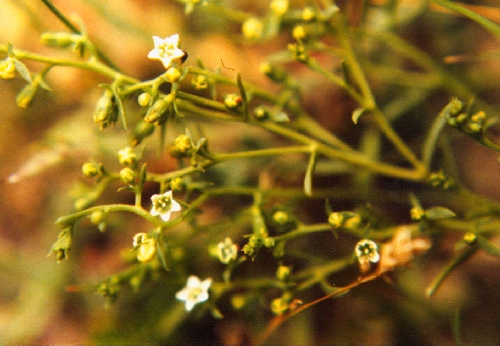 pears. Wild Clary Salvia verbenaca, Pyramidal Orchids and Celandine are still common on this part, which has not yet been sprayed. Large numbers of Buck's-horn Plantain, Fern grasses, Catapodium marinum and C. rigidum and Four-leaved Allseed Polycarpon tetraphyllum also occur. Rough Clover Trifolium scabrum and several of the other small clovers are frequent here.
pears. Wild Clary Salvia verbenaca, Pyramidal Orchids and Celandine are still common on this part, which has not yet been sprayed. Large numbers of Buck's-horn Plantain, Fern grasses, Catapodium marinum and C. rigidum and Four-leaved Allseed Polycarpon tetraphyllum also occur. Rough Clover Trifolium scabrum and several of the other small clovers are frequent here.
Broomrapes, principally Common Broomrape, Orobanche
..............................................................................Figure 17. Bastard Toadflax
minor, and Purple Broomrape, O. purpurea, are found in considerable quantity in the short turf, Variegated Catchfly Silene gallica var. quinquevulnera appears occasionally in a few dense patches along the track side, whilst along the line of the old fixed rim of the sandpit Hemlock Conium maculatum flourished until was regulaly mowed off after the pit filling was completed. Considerable quantities of Four-leaved Allseed, here usually coloured red through exposure to very dry, salty conditions, formerly were found on the south-facing wall of the now-filled excavation. Sea Sandwort (Honkenya peploides) is frequent behind the German sea-wall.
The eastern end of this region, beyond the tennis courts was the home of the rare Sand Catchfly Silene conica for many years and a few plants are still found at long intervals. Viper's Buglos Echium vulgare has appeared here in some quantity in the last 2-3 years, possibly spread from the disturbed soil, below beach gravel laid to form a car park for the Tennis Club.
.
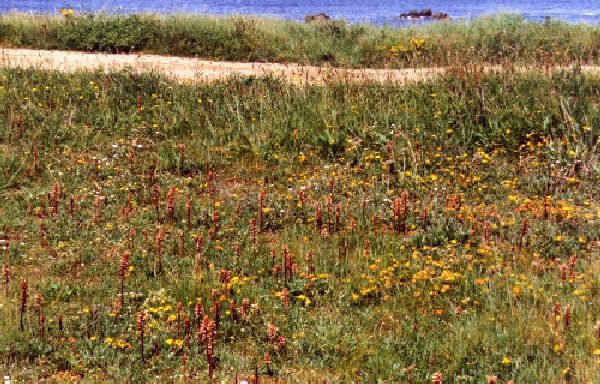
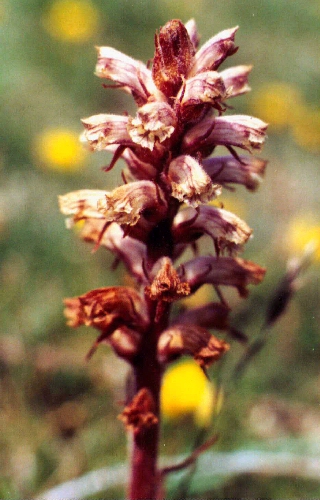 ...............................
...............................
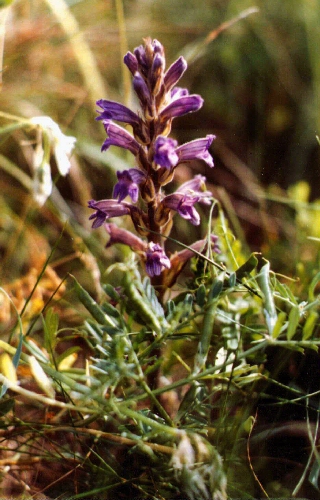
..............Figures 18/18a. Common Broomrape................................................... Figure 19. Purple Broomrape
...................
 .....................
.....................
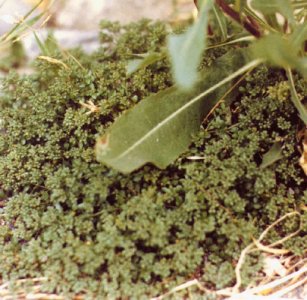
....................Figure 20. Hemlock ....Figure 21. Four-leaved Allseed >>>
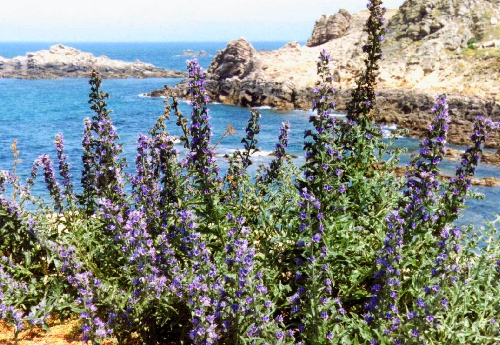
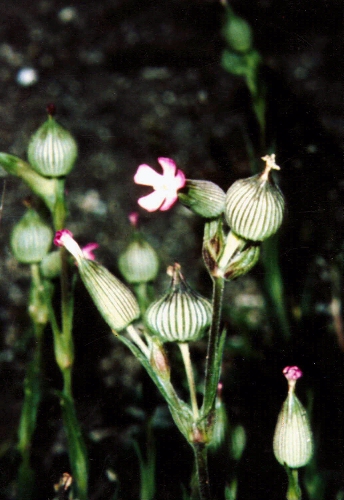
.......................Figure 22. Viper's Buglos ................................................................................Figure 23. Sand Catchfly
..
.
.
.
